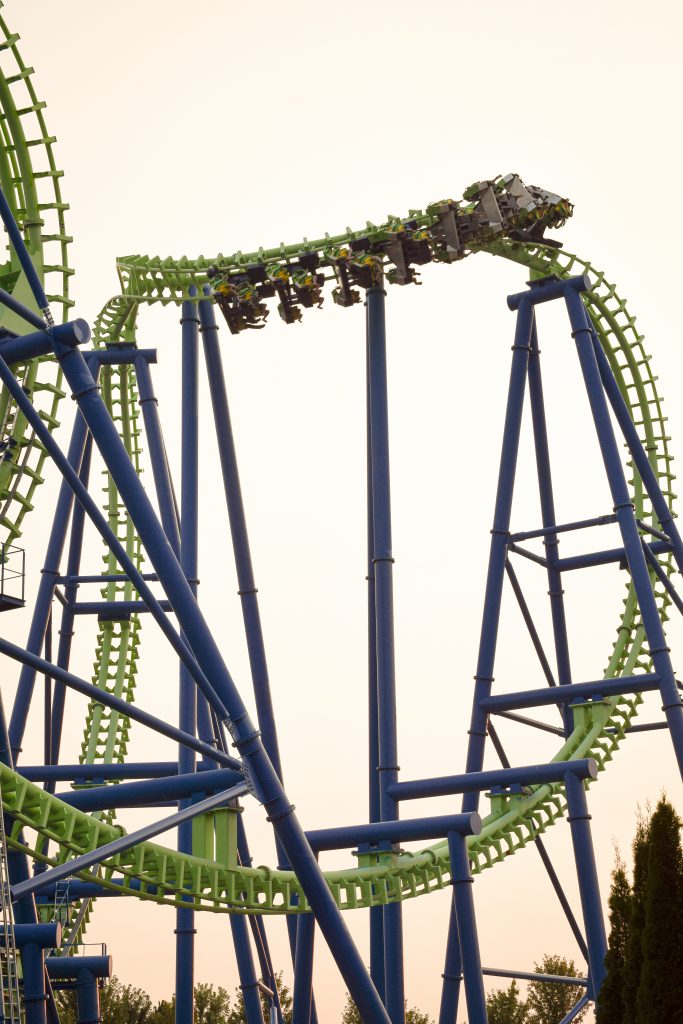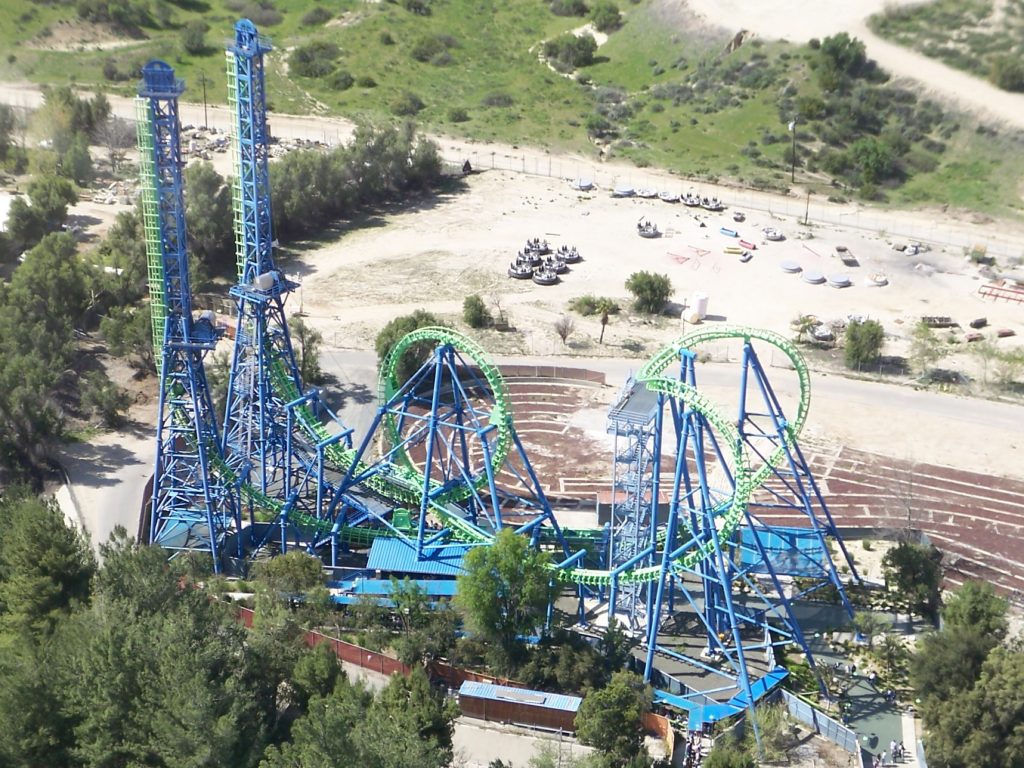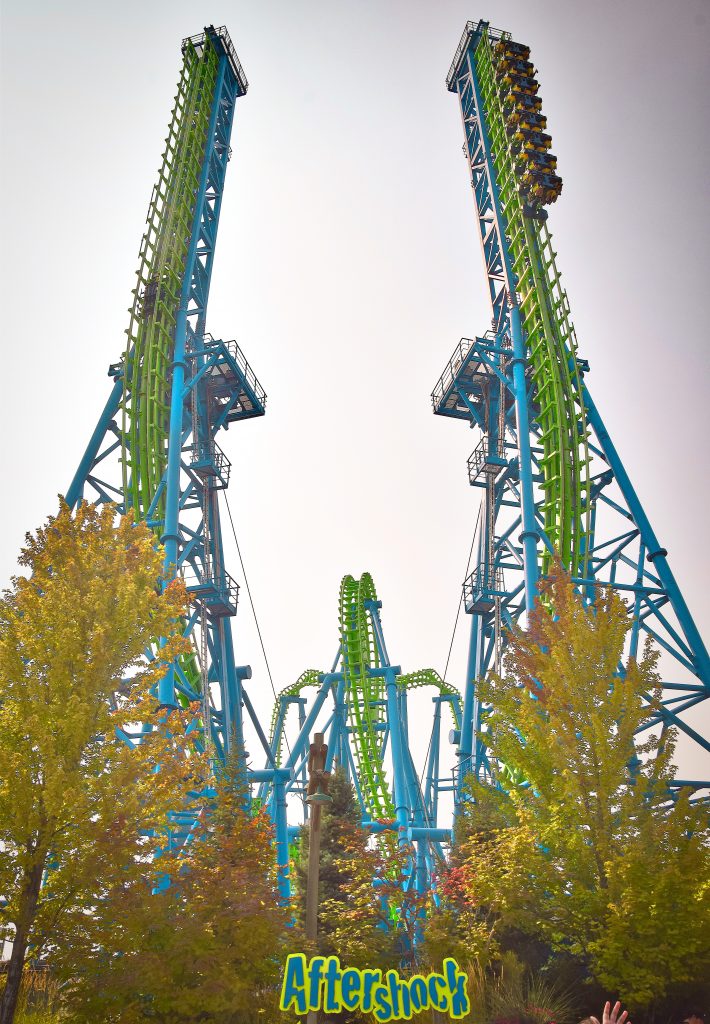In Part 9 of this series I briefly mentioned Six Flags ambitious expansion throughout the 1990s and early 2000s. A growing American economy made the expansion of the theme park market seem unstoppable. A series of park acquisitions and the acquisition of Six Flags by Premier Parks that was finalized in 1998 expanded the company’s portfolio to include European parks, movie themed parks, and animal parks. At the park level Six Flags unveiled park expansions and additions at a dizzying rate. From the years 1997-2003 Six Flags Magic Mountain received a brand new coaster every year. It is worth noting that with the exception of 1999 each one of these additions was a major, and in many cases record breaking coaster: 1997 saw the addition of the record breaking 400 ft tall Superman: The Escape. 1998’s Riddler’s Revenge remains the largest Stand-Up coaster in the world. 2000’s Goliath opened as the world’s tallest continuous circuit coaster. 2002’s X introduced the world to the 4th dimension coaster. And 2003’s B&M floorless Scream was built to be a reliable addition after X‘s problems. X was originally set to open in 2001 but was delayed significantly. Six Flags chose to open another major thrill machine from Vekoma. Unfortunately, this coaster would have its own set of problems. In August of 2001 Six Flags and Vekoma unveiled the world’s first “Giant Inverted Boomerang”, Deja Vu.
– In the past, many of our images have been posted, featured, and shared on forums, social media platforms and websites around the web. We work hard to provide the coverage that we do, and we encourage our audience to share our content and use our images, BUT ONLY IF proper credit is given to thecoasterkings.com. Thank you! –
This article aligns with a special podcast mini-episode! Click the logo below to listen to the podcast!

After the mixed success of the Invertigo model Vekoma decided the next step for this product line was to make it even larger. The boomerang design worked, the continuing sales of the original model showed that, but the giant inverted boomerang promised to make the model a major park centerpiece. Vekoma made the two spikes vertical and increased their height to 194 ft (59m) making Deja Vu the world’s tallest inverted coaster at its opening. A cable lift catch car system, similar to the original boomerang, lifts the coaster’s train up each spike. On the giant inverted boomerang there is a catch car on both spikes and no chain lift. Vekoma also slightly modified the boomerang layout with the vertical loop crossing over the station forming an x. Like the Invertigo, Vekoma also debuted a totally new train design. These trains featured 4 across seating but arranged in a v formation. The two center seats are next to each other while the outside seats are arranged slightly behind the center. This allowed for 4 riders per car and with trains of 8 cars the theoretical capacity was 32 riders per train, an improvement over the Invertigo and boomerang’s 28. The giant inverted boomerang sought to fix the Invertigo’s market problem. While still expensive it was of a scale that made it distinct enough for parks with an existing B&M invert, Vekoma SLC, or Boomerang.

Deja Vu debuted not only as the tallest, but the fastest (65.6 mph/105.6 kph) inverted coaster in the world adding another jewel to Magic Mountain’s coaster crown. It proved popular but some issues quickly manifested. During testing the coaster was prone to valley between the loop and the second tower (catch car issues) resulting in an evacuation structure being added to the coaster. There were also issues with the restraint locking system. Six Flags had ordered 4 giant inverted boomerangs for 2001 and other issues began to manifest at the other installations. Six Flags Over Georgia’s Deja Vu had a catch car derail. Six Flags Great America’s Deja Vu experienced valleying and during testing they noticed that tall riders could theoretically raise their hands up and touch the ride’s track. These problems led to significant modifications to all three attractions and a delay to the fourth giant inverted boomerang, Stunt Fall at Warner Bros. Park Madrid, until 2002.

The modifications made to the Magic Mountain installation seemed to work and it ran more reliably than its siblings. Magic Mountain’s Deja Vu also lasted longer. Six Flags Over Georgia closed Deja Vu in 2007 and it was sold to Brazil’s Mirabilandia Park. It has been in storage since 2009 with plans to open at an expanded version of the park. Unfortunately this relocation and expansion has faced numerous hurdles and the coaster’s future remains uncertain. Six Flags Great America also chose to retire the coaster after the 2007 season. Idaho’s Silverwood Theme Park bought the coaster where it has operated successfully as Aftershock since 2008. After a little over 10 years at the park, Magic Mountain’s Deja Vu was closed and relocated to Six Flags New England. Sporting the same color scheme the renamed Goliath opened in 2012 with new four-across trains by Premier Rides. These trains have become notorious in the enthusiast community for being uncomfortable and ruining much of the ride experience.

With the Six Flags order of four the giant inverted boomerang initially seemed about as successful as the invertigo model which preceded it. In a move which surprised enthusiasts, China’’s Jin Jiang Action Park debuted Giant Inverted Boomerang in 2011, 10 years after Deja Vu’s debut. Another installation followed in 2014 with Quantum Leap at Russia’s Sochi Park. While not the runaway success of the Boomerang or SLC it seems this coaster model line might still have some life left in it. In 2011 when Six Flags Magic Mountain removed Deja Vu they briefly tied with Cedar Point for having the most coasters in the World. A set of steady additions has resulted in Magic Mountain regaining the lead, and remains to have the highest number of coasters at a single park to this day. Many of the frenzied additions of the 90s and 2000s remain signature parts of the park’s line up. Deja Vu was just one part of that story but it is an era that has shaped the park that Magic Mountain is today.
I hope you enjoyed the final installment of Lost Coasters of California. It is amazing how much coaster history California has witnessed in the time following Corkscrew‘s debut in 1975. If you haven’t make sure to check out the rest of this series on Coaster Kings and the accompanying series on Coaster Kings Radio. I’ll be back soon with more park and industry history.



Bravo!
One Small comment.. When Goliath opened at SFNE.. it DID have the original trains (I rode it)… Shortly thereafter they were changed to the premiere trains.